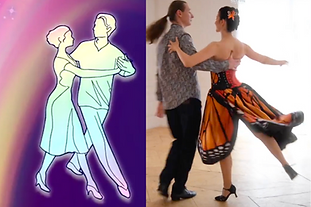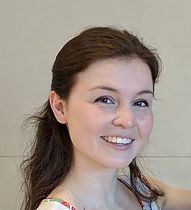
Tuesday Night Couple Dancing Classes
The series is postponed until this Fall.
Tuesday evenings, beginning October 1st
A six-week series of partnered social dance classes
held in the large dance hall of the First United Methodist Church, 625 Hamilton Ave, Palo Alto, CA 94301

Have questions? Check out our FAQ at the bottom of this page.
Beginning:
Cross-Step Waltz Basics
7:00 pm - 7:55 pm

Learn noncompetitive waltz. Cross-step waltz was discovered and developed at Stanford, and is one of the quickest-to-learn forms of waltz. We’ll go through the basics then on to many variations. This is also a great introduction to partner dancing.
No dance experience is required, just a fun-loving attitude and enthusiasm.
Intermediate:
Cross-Step Waltz Musicality
8:00 - 8:55 pm

Now that you know the cross-step waltz basics, learn how to match your variations to the music. A dancer with strong musicality will be able to recognize and predict energy changes in the music, then adapt their waltzing to the unique character of each song.
Prerequisite: Know the cross-step waltz basic step and at least a few patterns.
Intermediate to Advanced:
Fast Track to Salsa for Dancers
9:00 pm - 9:55 pm

This class is a fast-paced comprehensive salsa class. We’ll start with the basics on the first week then move to flashy variations like arm-flicks, copa, hammerlocks, fancy turns, dips and more. This is a great next step for those who have completed the basic series.
Prerequisite: Be proficient in at least one other dance form or know some salsa.
Price
$40 for students, $60 for non-students for each of the three courses.
The price includes all six classes.
The rent has gone up three times in the past year and a half, but we are keeping these prices the same as before.
Each hour-long class costs about $6.50 (students), and $10 (non-students).
At a fraction of the cost at most other studios, these classes are a great value.
Once you've made the drive, stay for a second or third class!


Cameron Schaeffer
A former student of Richard Powers, Cameron has performed with the Stanford Viennese Ball Opening, Stanford Swingtime, and Los Salseros de Stanford while a student. He placed 1st at the Stanford Viennese Ball Waltz competition multiple times and is a former member of a semi-pro salsa performance team. Cameron enjoys sharing the magic of social dance with others.
Rocky Aikens
Rocky is a protégé of Richard's who brings her own touch to the dance floor. Her dancing is shaped by more than a decade of social dance experience across genres and dance roles.
The Teachers
The Dance Space
First United Methodist Church
625 Hamilton Ave, Palo Alto, CA 94301
The community space at First United Methodist Church is a large dance space with a wood floor. It is located in downtown Palo Alto, biking distance from Stanford campus.
Some parking is available in the church parking lot. There is also an abundance of street parking, and the large Webster/Cowper parking garage one block away.
Beginning: Cross-Step Waltz Basics
Dive into the enchanting world of Cross-Step Waltz with our beginner's course, designed for those stepping onto the dance floor for the first time or looking to add a new style to their repertoire.
This class focuses on the foundational steps of Cross-Step Waltz, a dance known for its romantic flow and elegant simplicity. Students will learn the basic step pattern that distinguishes Cross-Step Waltz from other styles, along with introductory turns and promenades that showcase the dance's fluidity and grace.
Emphasis will be placed on connection with the partner, musicality, and the joy of moving together in harmony. This welcoming environment encourages personal expression and creativity, making it the perfect starting point for anyone eager to embark on a dancing journey.
No prior experience is required—just bring your enthusiasm and a readiness to fall in love with dancing.
This class is a fun place to start partner dancing.
If you already dance, bring a friend who doesn't. This is a great way to introduce someone to couple dancing.
No prerequisites, just a fun-loving attitude and lots of enthusiasm!
Intermediate: Cross-Step Waltz Musicality
Now that you know the cross-step waltz basics and some patterns, learn how to match your variations to the music.
A dancer with strong musicality will be able to mold the speed and texture of the variations they know to match the nuances of the music, from the pace and beats to the mood and changes in tone.
Musicality is not just about moving to music but interpreting it in a way that adds depth and emotion to the dance, creating a connection with their partner that brings the music to life through movement. We'll teach:
1. How to predict when energy changes will occur in a song
2. How to adapt the speed/texture of moves you already know to match these changes
3. A fun and challenging waltz choreography so you can experience dancing to different layers of a song and changing the speed/size of patterns to match changes in the music.
Prerequisite: Know the cross-step waltz basic step and at least a few patterns.
Intermediate to Advanced: Fast Track to Salsa for Dancers
This class is designed to be a fast paced comprehensive salsa class for those who already know another dance form.
We’ll start the first week with the basic step and basic turn technique. Each week builds on the last, introducing elements like arm flicks, dips, intricate turn patterns, hammerlocks, and dynamic variations such as the copa and hook turn.
Special focus is given to developing precise lead and follow techniques, enhancing partner connection, and mastering spin and dip execution.
The course culminates with a choreography taught in the final week that incorporates everything we learned.
Whether you're a seasoned dancer in another genre looking to expand your repertoire or seeking to refine your salsa with advanced concepts, this course offers the perfect blend of challenge and enjoyment, set in a supportive and energetic atmosphere.
This is a great next step for those who just completed the 6 week series on Bachata, Salsa, and Cha-cha and want to learn more complex figures and techniques.
Prerequisite: Be proficient in at least one other dance form or have taken some salsa classes before.
Frequently Asked Questions
There are three rules in social dance:
-
Smile at your partner
-
Laugh at yourself.
-
If you and your partner are having fun, you're doing great.
...that being said, here are some things you might also want to know:
Do I need a partner?
Nope! We rotate partners in class. This really speeds up learning for everyone and puts the "social" in "social dancing." You have the option to enroll with a partner who you can start and end the class with, but it is perfectly normal not to have one.
We roll balance the classes upon registration, so you won't have to worry about not having a partner often, due to too many Leads or Follows in the class.
Do you really really want to dance only with the partner you came with? Talk to your instructor when you arrive. It's not absolutely required to rotate partners (especially if you have health concerns about rotating), but you will learn faster if you dance with many people.
What do I wear?
Clothes: Wear comfortable clothes that you can move around in.
-
Note: Some dance moves involve spins. If you arrive in a skirt, you may be more comfortable with shorts underneath.
Shoes: For beginner classes, most shoes will be serviceable, and many students will even wear socks to class. Don't let a lack of perfect shoes keep you from dancing. If you have some options, opt for comfortable shoes with somewhat slippy bottoms (cloth or leather soles work well). Sneakers can have too much traction. Avoid high, spiked heels or big, chunky shoes with platform soles. They don't generally afford enough agility and can be dangerous and painful if you happen to step on your partner's foot.
What is your COVID-19 policy?
We request that all students are vaccinated against COVID-19. Masks are still recommended, but are optional.
What if I have no dance experience?
One thing that makes social dance special is that most social dancers begin dancing as adults. You will not be alone.
What if I have to miss a class?
Missing a class or two is not a problem, as long as you find ways to keep up with the material. We always send emails with descriptions and demonstration videos of what we learned. You can read the descriptions, and/or watch the videos, and practice on your own.
Should I pre-register as a Lead or Follow?
That's entirely up to you!
In most partner dancing, the "Lead" suggests which dance moves to do, and the "Follow" interprets cues from the Lead. In the Old Days, the "men" led, and the "ladies" followed, but many things were different in the Old Days. Nowadays, many dancers eventually learn both roles.
We do ask that you pick one role and stick with it for the whole six week class so that you don't fall behind. Also, enrollment is role-balanced, and if you switch roles, you may cause an imbalance, and others may have to stand out more often in rotations.
The Enrollment Game: We role-balance enrollment. If you are willing to dance either role, you may have an easier time getting into classes. If you are waitlisted for a particular role, please let us know if you're willing to sign up for the other role.
What's my registration status?
Classes typically fill up, and we also role-balance enrollment, so filling out the registration form does not guarantee that you are in the class.
When your enrollment request is processed, we will send you an email with your status. You will either be admitted, waitlisted because the class is full, or waitlisted because of role balance. If you are admitted, you will get an email with a link to pay for the course. If you are waitlisted, we will send you a follow-up email if/when you make it off the waitlist.
Can I take more than one class?
Yes! As long as you've made the trip, stay for one or two more classes that you think you might be qualified for.
Other questions? Contact us.
More questions? Email Richard.
